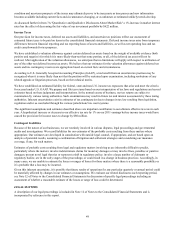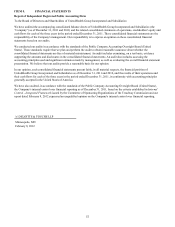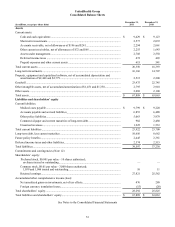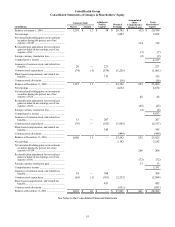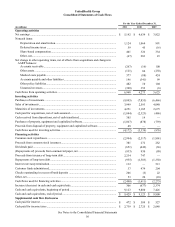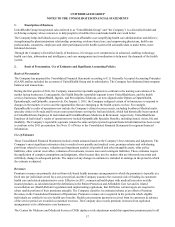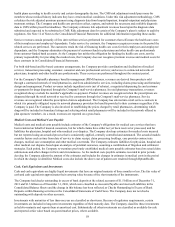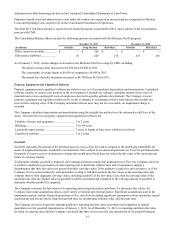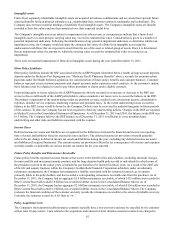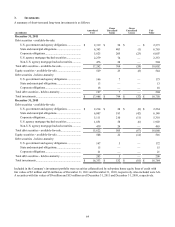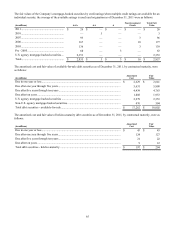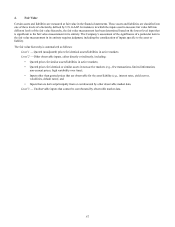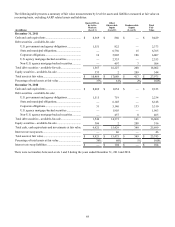United Healthcare 2011 Annual Report Download - page 61
Download and view the complete annual report
Please find page 61 of the 2011 United Healthcare annual report below. You can navigate through the pages in the report by either clicking on the pages listed below, or by using the keyword search tool below to find specific information within the annual report.59
The Company excludes unrealized gains and losses on investments in available-for-sale securities from earnings and reports
them, net of income tax effects, as a separate component of shareholders' equity. To calculate realized gains and losses on the
sale of investments, the Company uses the specific cost or amortized cost of each investment sold.
The Company evaluates an investment for impairment by considering the length of time and extent to which market value has
been less than cost or amortized cost, the financial condition and near-term prospects of the issuer as well as specific events or
circumstances that may influence the operations of the issuer and the Company's intent to sell the security or the likelihood that
it will be required to sell the security before recovery of the entire amortized cost.
• For debt securities, if the Company intends to either sell or determines that it will be more likely than not be required
to sell a security before recovery of the entire amortized cost basis or maturity of the security, the Company recognizes
the entire impairment in Investment and Other Income. If the Company does not intend to sell the debt security and it
determines that it will not be more likely than not be required to sell the security but it does not expect to recover the
entire amortized cost basis, the impairment is bifurcated into the amount attributed to the credit loss, which is
recognized in earnings, and all other causes, which are recognized in other comprehensive income.
• For equity securities, the Company recognizes impairments in other comprehensive income if it expects to hold the
security until fair value increases to at least the security's cost basis and it expects that increase in fair value to occur in
a reasonably forecasted period. If the Company intends to sell the equity security or if it believes that recovery of fair
value to cost will not occur in a reasonably forecasted period, the Company recognizes the impairment in Investment
and Other Income.
New information and the passage of time can change these judgments. The Company manages its investment portfolio to limit
its exposure to any one issuer or market sector, and largely limits its investments to U.S. government and agency securities;
state and municipal securities; mortgage-backed securities; and corporate debt obligations, substantially all of investment grade
quality. Securities downgraded below policy minimums after purchase will be disposed of in accordance with the investment
policy.
Assets Under Management
The Company provides health insurance products and services to members of AARP under a Supplemental Health Insurance
Program (the AARP Program), and to AARP members and non-members under separate Medicare Advantage and Medicare
Part D arrangements. The products and services under the AARP Program include supplemental Medicare benefits (AARP
Medicare Supplement Insurance), hospital indemnity insurance, including insurance for individuals between 50 to 64 years of
age, and other related products.
The Company's arrangements with AARP extend to December 31, 2017 for the AARP Program and give the Company an
exclusive right to use the AARP brand on the Company's Medicare Advantage and Medicare Part D offerings until
December 31, 2014, subject to certain limited exclusions.
Pursuant to the Company's agreement, AARP Program assets are managed separately from its general investment portfolio and
are used to pay costs associated with the AARP Program. These assets are invested at the Company's discretion, within
investment guidelines approved by AARP. The Company does not guarantee any rates of return on these investments and, upon
transfer of the AARP Program contract to another entity, the Company would transfer cash equal in amount to the fair value of
these investments at the date of transfer to that entity. Because the purpose of these assets is to fund the medical costs payable,
the rate stabilization fund (RSF) liabilities and other related liabilities associated with this AARP contract, assets under
management are classified as current assets, consistent with the classification of these liabilities. Interest earnings and realized
investment gains and losses on these assets accrue to the overall benefit of the AARP policyholders through the RSF.
Accordingly, they are not included in the Company's earnings. Interest income and realized gains and losses related to assets
under management are recorded as an increase to the RSF and were $99 million, $107 million and $99 million in 2011, 2010
and 2009, respectively.
The effects of changes in balance sheet amounts associated with the AARP Program also accrue to the overall benefit of the
AARP policyholders through the RSF balance. Accordingly, the Company excludes the effect of such changes in its
Consolidated Statements of Cash Flows. For more detail on the RSF, see "Other Policy Liabilities" below.
Other Current Receivables
Other current receivables include amounts due from pharmaceutical manufacturers for rebates and Medicare Part D drug
discounts, reinsurance and other miscellaneous amounts due to the Company.


